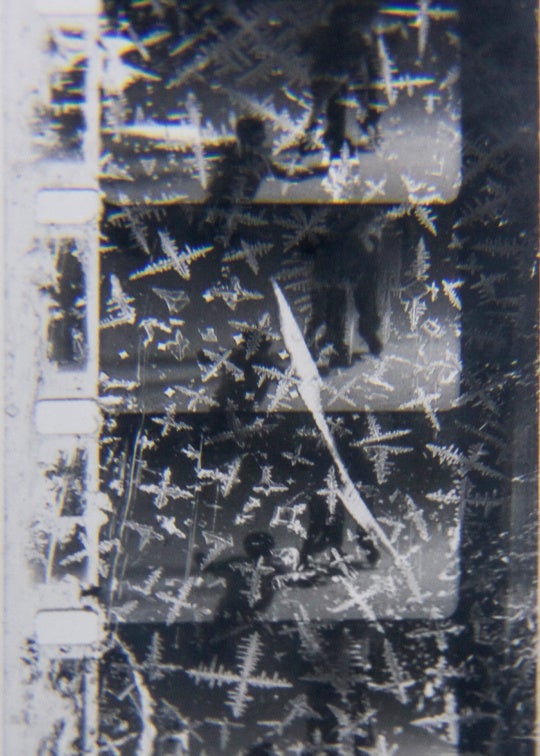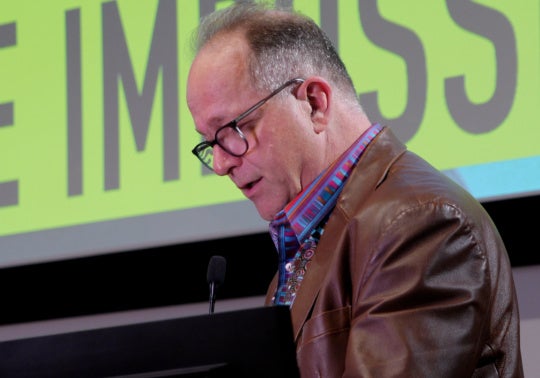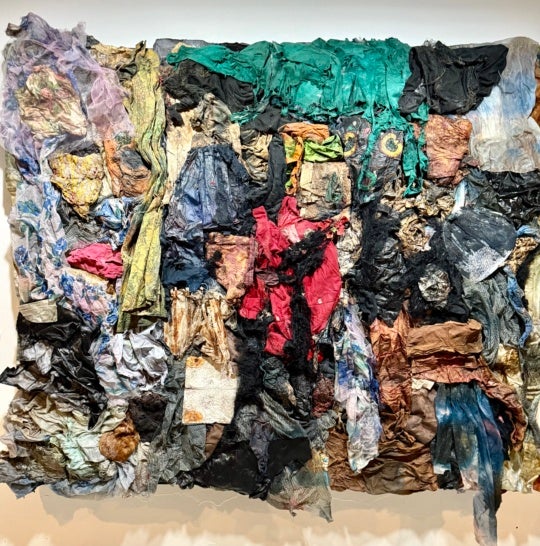
It Takes A Village: Yarn BOMB! at the Marietta/Cobb Museum of Art
This proverb, It Takes A Village, has become increasingly popular as humans seek connection to one another in the face of what can often be a disconnected existence. It takes many hands to create, and a body of people committed to community, to realize large installations such as Yarn BOMB! @MCMA [Marietta/Cobb Museum of Art, through September 2013]. How apt for that proverb to greet me as I walked up to the front museum entrance, and what a colorful and warm welcome it was on the first sunny day Atlanta has seen in quite a while. Yarn BOMB! @ MCMA involved 250 individuals from Marietta, greater Atlanta communities, and visiting students from Yantai University in China and Wayne Thomas Elementary in Indiana. Six columns of its Greek revival building have been covered 11 feet from the ground and numerous other surfaces have been embellished.
Yarn Bombing is non-permanent graffiti that uses knitted or crocheted yarn instead of paint or chalk to transform a public object or space. While credited to this [current] generation, there are examples of it on a smaller scale during the fiber arts movement of the 70’s. Around 2002, it gained momentum as groups of artists adopted it as a hybrid form of social statement, post-feminist dialogue and collective DIY art making. A citizen’s group declared June 11, 2011, as the very first Yarn Bombing Day.
Yarn humanizes cold surfaces and makes an urban environment more alive; in contrast to the hard-edged tags of urban graffiti, it is a profoundly accessible and psychologically comforting medium. Many examples are also used as important social and political commentary such as Pink M24 Chaffee (2006) by Danish artist Marianne Jorgensen, which is a WWII military tank covered in pink knitted squares as a protest against the Danish (USA’s, UK’s) involvement in the Iraq war.
Participating in activities such as this helps promote wellbeing and also initiates critical dialogue. While at the [Marietta/Cobb] museum, I questioned a group of young students attending summer camp about their response to the yarn bomb and was greeted with both enthusiasm and wise responses to another question: What is art and what is craft? Some students had also participated [in the yarn bombing] and those spoke on the fun dichotomy of being both makers and group participants. Katie Bush, MCMA’s director of education, says her goal in putting on the yarn bomb was to build community through art. Her inspiration for this endeavor came from a yarn-bombed bridge she saw while visiting Switzerland last year.
Knit the Bridge is going on in Pittsburgh right now, which will realize the entire Andy Warhol Bridge covered in (what will become) the world’s largest yarn bomb to date! The Marietta/Cobb Museum of Art yarn bombing is a wonderful start to what should become an on-going project with the potential to include more happy villagers.
-Leisa Rich

Uninhabited: Larry Jens Anderson’s Animal Farm at Kai Lin
Kai Lin’s current exhibition by Larry Jens Anderson, Uninhabited, presents drawings of animals (both domesticated and wild) displaced from their conventional context of a natural, wild environment [May 10-July 5, 2013]. Now situated with fixed purpose they invite one’s own experience to judge the significance behind their frank, animalistic grace.
Anderson’s artistic hand is present as he leaves his physical marks apparent: the drawings exude a youthful-like vibrancy seen via their impulsive nature. The artist’s hand is explicit upon the paper and his sketched lines trace every twist and turn. Anderson allows for his lines to sweep across the expanded notebook paper so that viewers may witness his process of creation through scribbles, lines, and ink blots uniting together to devise new forms.
Nevertheless, Anderson’s work also undeniably declares a defining tone: Anderson executes sophisticated but playful calligraphic strokes. The images are simple but the candid quality of Anderson’s work thickens the potential meaning, moving it away from amateur children’s book illustrations. His drawing, Elephant, renders a confrontational, grand animal now altered into more of a soft abstraction, with the elephant’s ears mirroring butterfly wings. Perhaps this illusion is reinforced by Anderson’s style that may mimic Japanese ink wash. The overlapping lines, the perceptible skeletal structure of his figures, as well as the woodwork panels bleeding through certain canvases, manifest that the artist does not hide behind a final, crisp, and perfected image. His use of transparency through material is a mature, minimalist-styled honesty, as if his childhood mind is gushing out as a stream of consciousness or a sequence of comforting memories. He presents whimsical animals that have customarily made their way into bedtime stories and entertaining cartoons, but not this time: each animal’s visual malleability redefines its character with each new set of eyes.
-Dasha Vzorov

NATURE: Four Ways by Ronald Nuse at Callanwolde Fine Arts Center
Currently on view at Callanwolde Fine Arts Center Gallery is NATURE: Four Ways, a collection of past and current works by the Georgia-based photographer, Ronald Nuse [June 7-August 30, 2013]. Located in a small room on the second floor of the Arts Center, Nuse presents four different approaches to nature photography. Arranged on the middle of every wall, the gallery lends itself to a diverse interpretation of “nature” through the lens of street art, digitally combined landscapes, surrealism, and pictorial repetition, each represented by a different photographic series [Falling Shadows, Street Art, Four Directions, and Bamboo Pentychs]. Overall, Nuse’s photographic techniques capture the rich presence and ambiance of nature. His photos offer fresh and surprising compositions that redefine how one understands and navigates the natural environment.
Two of Nuse’s series, Street Art and Falling Shadows, appear to be the most conceptually developed of the four. Street Art investigates the combination of public art with nature through digital photography that is not heavily manipulated. This series instantly reminds one of ephemeral qualities in the natural environment. In Trees Vines and Painted Wall (2012), green leaves and branches surround brightly colored graffiti on a concrete wall. The green leaves are reminiscent of how the environment is constantly changing; each person may experience the landscape differently based on the season or time period in which it is viewed. In contrast, the series Falling Shadows exhibits digitally altered photos made through combining multiple landscapes. Take for example Ascending (2011), which combines highly contrasted bark, leaves, sky, and moss layered atop one another. This series helps viewers to see nature as a mysterious combination of elements in the physical world. As a result, NATURE: Four Ways also represents the unpredictable juxtapositions present in nature. Although the altered landscapes in this series are completely constructed, it takes time for the viewer to realize this. The composition of the natural world is highly variable, allowing one to see nature as amalgamations of mysterious combinations, represented in the physical world.
-Edith Braggiotti-Painting

Dead of Night: paintings by Mimi Hart Silver, at Whitespace
Mimi Hart Silver is an artist with a great deal of technical skill. Dead of Night consists of high-shine paintings made from photographs of her brother skinning and cleaning the carcasses of wild animals [Whitespace Gallery, June 21-July 27, 2013]. The bloody physicality of the act dissolves into a swish of bulging organs, pink hands, milky pulled skins, fur, and feathers. Everything evaporates into shafts of light that pierce a glittering darkness. Hart Silver photographs, then glazes, varnishes, and ultimately, packages the light that falls on the action of stripping the creatures. They read as photographs, though transcribed in paint.
As photography rendered moot painting’s obligation to the representation of nature, it opened a door to the echo chamber of self-referentiality, and these paintings bundle their reverberations in a tight spiral. Photography, painting, death, ritual, family ties, chiaroscuro illuminations, and Southern Gothic fuse and point at each other with empty eyes.
Despite the crowded queue, these are the moments following death, the taciturn times when the business of departure is underway. Death comes, and inevitably, the rituals follow. Everything here is necessary, and somehow perfectly sensible for all of its phantasmagoric lingerings. There is only a trace of terror in the seeping blood around the rim of the bucket in Universe (2013). These paintings display Hart Silver’s skills at processing, and if you look close enough you can actually see the attenuating tail of the oroboros being eaten by her meticulous labor. In fact, look a little closer and you might see the reflection of your own face in the winking blackness that surrounds the bodies. Death and its gothic accouterments have been digested again.
-Karley Sullivan
House rules for commenting:
1. Please use a full first name. We do not support hiding behind anonymity.
2. All comments on BURNAWAY are moderated. Please be patient—we’ll do our best to keep up, but sometimes it may take us a bit to get to all of them.
3. BURNAWAY reserves the right to refuse or reject comments.
4. We support critically engaged arguments (both positive and negative), but please don’t be a jerk, ok? Comments should never be personally offensive in nature.




